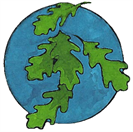


Distribution
Foxtail pine is broken into two subspecies: Pinus balfouriana subsp. austrina R.J. & J.D. Mastrogiuseppe, which is the Southern Foxtail Pine and Pinus balfouriana subsp. balfouriana, which is the Northern Foxtail Pine. The two subspecies have probably been separated since major geological disturbances early in the Pleistocene epoch.
Botanical
The champion Foxtail Pine in the Trinity National Forest is 76 feet tall, but the typical height is between 20-50 feet and 1-2 feet in diameter. It is a
Foxtail pine is broken into two subspecies: Pinus balfouriana subsp. austrina R.J. & J.D. Mastrogiuseppe, which is the Southern Foxtail Pine and Pinus balfouriana subsp. balfouriana, which is the Northern Foxtail Pine. The two subspecies have probably been separated since major geological disturbances early in the Pleistocene epoch.
Botanical
The champion Foxtail Pine in the Trinity National Forest is 76 feet tall, but the typical height is between 20-50 feet and 1-2 feet in diameter. It is a
Sources:
Trees of North America- A guide to field identification-a Golden Field Guide from St. Martin's Press © 2002 By C. Frank Brockman p.24
The Encyclopedia of North American Trees by Sam Benvie. Firefly Books Ltd., 2000 Buffalo, NY © 2000 Sam Benvie p.160, 161
USDA, NRCS. 2011. The PLANTS Database (<http://plants.usda.gov/>, 22 August 2011). National Plant Data Team, Greensboro, NC 27401-4901 USA.
Fryer, Janet L. 2004. Pinus balfouriana. In: Fire Effects Information System, [Online]. U.S. Department of Agriculture, Forest Service, Rocky Mountain Research Station, Fire Sciences Laboratory (Producer). Available: http://www.fs.fed.us/database/feis/ [2011, August 22].
Trees of North America- A guide to field identification-a Golden Field Guide from St. Martin's Press © 2002 By C. Frank Brockman p.24
The Encyclopedia of North American Trees by Sam Benvie. Firefly Books Ltd., 2000 Buffalo, NY © 2000 Sam Benvie p.160, 161
USDA, NRCS. 2011. The PLANTS Database (<http://plants.usda.gov/>, 22 August 2011). National Plant Data Team, Greensboro, NC 27401-4901 USA.
Fryer, Janet L. 2004. Pinus balfouriana. In: Fire Effects Information System, [Online]. U.S. Department of Agriculture, Forest Service, Rocky Mountain Research Station, Fire Sciences Laboratory (Producer). Available: http://www.fs.fed.us/database/feis/ [2011, August 22].
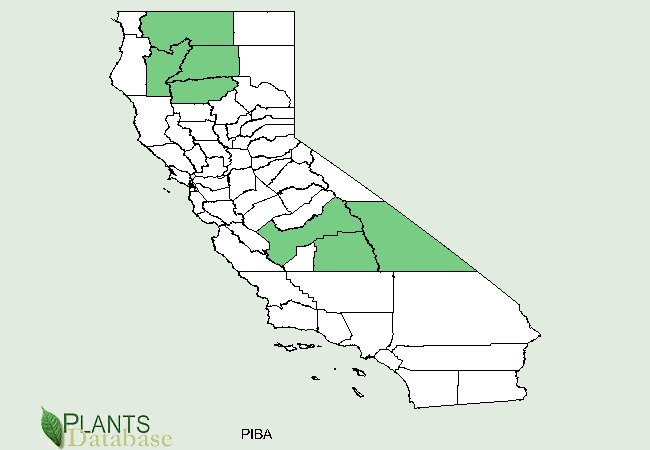
accounts state 20 years. Up curved at the tips, the needles are stiff, prickly tipped and may have a waxy substance on the inner surface. Male cones are vivid yellow, as seen in the image to the left. Females are purplish-brown to reddish-brown. They are 3-5 inches long and the scales are tipped with a small curved prickle. Seeds of the Foxtail Pine are pale brown, spotted with red, and are single-winged. The structure of the tree depends on site specifics. In open areas such as rocky out croppings and ridges, it is often found with a Krummhulz form, meaning twisted and deformed by winds. Where protected from high winds, it forms a broad conical to irregular crown.
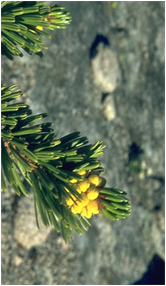
slow growing tree. The reddish-brown bark is furrowed and vertically ridged. Twigs are red-brown when young, turning yellowish-gray when mature. It's needles are short, only 1-2 inches long, and are densely clustered in bundles of 5, giving the species its distinct foxtail-like appearance. They persist on the tree for 10-12 years, although some
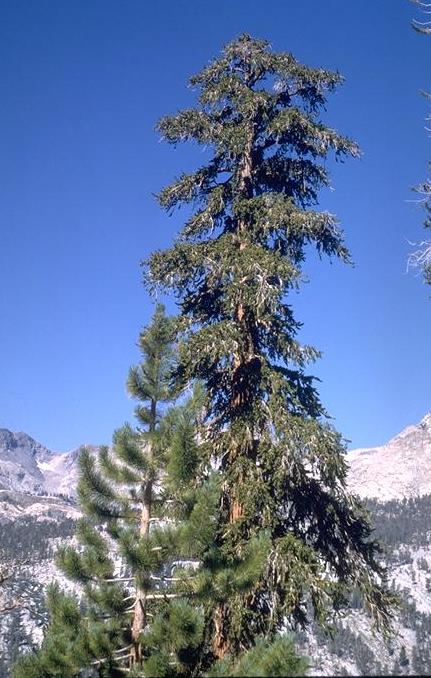
Habitat
It's preferred habitat is on poor rocky soils that are dry, well-draining and usually exposed. Pinus balfouriana
It's preferred habitat is on poor rocky soils that are dry, well-draining and usually exposed. Pinus balfouriana
Photo citation: © 1995 Saint Mary's College of California, Brother Alfred Brousseau. Male cones, foxtail pine
Photo citation: © 1995 Saint Mary's College of California, Brother Alfred Brousseau. Foxtail pine (in front)
is typically found at higher elevations on sandy to gravelly soils on out croppings, ridges and cliffs. Best growth is attained on fast draining, infertile, sandy soils.
Uses
Foxtail Pine is a rare tree, but it is cultivated as an ornamental landscape tree. It also helps control soil erosion and is valuable in watershed management.
Uses
Foxtail Pine is a rare tree, but it is cultivated as an ornamental landscape tree. It also helps control soil erosion and is valuable in watershed management.





™
- Trees
- A-Z scientific
- A-Z by Common Name
- Families
- Aceraceae Maple Family
- Anacardiaceae Sumac Family
- Annonaceae Custard Apple Family
- Aquifoliaceae Holly Family
- Arecaceae, Palm Family
- Betulaceae Birch family
- Bignoniaceae Trumpet Creeper Family
- Burseraceae Frankincense Family
- Caprifoliaceae Honeysuckle Family
- Chrysobalanaceae Coco-plum Family
- Cornaceae Dogwood Family
- Cupressaceae Cypress Family
- Cyrillaceae Cyrilla Family
- Ebenaceae Ebony Family
- Ericaceae Heath Family
- Fabaceae Pea Family
- Fagaceae Beech Family
- Hamamelidaceae Witch Hazel Ffamily
- Hippocastanaceae Horse Chestnut Family
- Juglandaceae Walnut Family
- Lauraceae Laurel Family
- Leitneriaceae Corkwood Family
- Magnoliaceae Magnolia Family
- Meliaceae Mahogany Family
- Moraceae Mulberry Family
- Myricaceae Bayberry Family
- Myrsinaceae Myrsine Family
- Myrtaceae Myrtle Family
- Nyctaginaceae Four Oclock Family
- Olacaceae Olax Family
- Oleaceae Olive Family
- Pinaceae Pine Family
- Platanaceae Plane Tree Family
- Polygonaceae Buckwheat Family
- Rhamnaceae Buckthorn Family
- Rosaceae Rose Family
- Rubiaceae Madder Family
- Rutaceae Rue Family
- Salicaceae Willow Family
- Sapindaceae Soapberry Family
- Sapotaceae Sapodilla Family
- Simaroubaceae Quassia Family
- Styracaceae Storax Family
- Symplocaceae Sweetleaf Family
- Theaceae Tea Family
- Tiliaceae Lindon Family
- Ulmaceae Elm Family
- Taxaceae Yew Family
- Yucca Family
- Browse by State
- Rare or Endangered Species
- Trees_with_Special_Uses
- Tallest and Biggest
- Noxious Weeds
- Causes
- About Us
- Our Stores

Custom Search
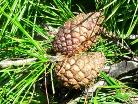
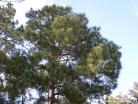
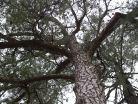
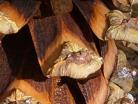
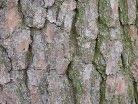
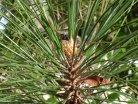
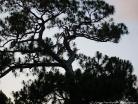
Want to add your tree to our picture gallery? Click here for details!
Tree lists:
•A-Z by scientific
name
•A-Z by common
name
•By Family
For state A-Z list click state name below.
•A-Z by scientific
name
•A-Z by common
name
•By Family
For state A-Z list click state name below.
-Color denotes a tree that is rare or endangered

Foxtail Pine,
Pinus balfouriana Balf.
Common Names: Southern Foxtail Pine, Northern Foxtail Pine, Sierra Foxtail Pine, Klamath Foxtail Pine
Pinus balfouriana Balf.
Common Names: Southern Foxtail Pine, Northern Foxtail Pine, Sierra Foxtail Pine, Klamath Foxtail Pine

Native distribution map for Pinus balfouriana
Map courtesty USDA NRCS PLANTS Database
Map courtesty USDA NRCS PLANTS Database
